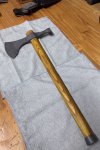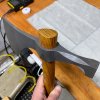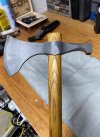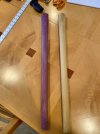IIRC most of the "fighting hawks" from French and Indian Wars time period were not very large or heavy, and tended to have longish spikes. I imagine folks wore a lot heavier and more durable clothing to get the same insulation value as today's fabrics.
Coming from a Kali background I quickly found most of the hawks out there in practice would be something to swing for the fences while issuing your war cry, there will be very slow recovery of missed shots or tangled heads. Many of the modern fighting hawks are much smaller, full length steel construction to balance out the weight.
The heavier ones are good for pure exercise and chopping stuff, beautiful hawk BTW!
Agree with this. Did a lot of research on historic spike tomahawks, and was surprised to find out how different they were, even from the modern tomahawk market—including the full tang kali fighting tomahawks. It’s rare to find a tomahawk, especially a full tang, that weighs less than 20 ounces. Many historic spike tomahawks averaged just 8-10 ounces, head and handle. A few examples are below 6 ounces, total, in weight. I got to meet and interview Jack Vargo, who wrote the book on spike tomahawks, and hold examples—it’s clear that these were built for speed—blindingly fast in the chop.
In my own experiments, I modified tomahawks by aggressively removing mass and testing against skull surrogates (coconut wrapped in thin strips of meat). I found that anything over 12 ounces required too much wind up in the chop and too slow of a recovery to feel “quick.” 10 ounces felt truly fast. 8 ounces or less was crazy quick. Definitely need to go with more concentrated chopping edge designs when you get this light. These experiments shed a lot of light on why these historic designs worked so well.
Warriors in the Iroquois Confederacy was also known to throw their tomahawks in combat—not in running starts either—historic accounts show these were thrown at first instant of contact from most any body posture, even thrown from behind cover. In my experiments, tomahawks 10 oz or less could be thrown at surprisingly high speed with little wind up. I am not athletic but we measured close to 40 feet per second on throws primarily with arm motion alone. At close range that’s difficult to defend/duck/dodge.
There’s a wide diversity of designs in historic spike tomahawks but today, most are making straight spikes, often needle tip sharp and definitely risking self injury. Historically, curved spike designs were quite common—many so curved to make percussive impact wounds impossible—these were meat hooks on sticks for catch and drag. I speculate the curved spikes were favored to reduce risk of self injury. Even many of the historic straight tomahawk spikes, which improve probability of wounding in the throw, often featured blunted or chisel tipped spikes. Plenty of force concentration to penetrate a person (plus clothing) in a committed blow or throw, but less risk of self-injury to the user. A lot of these historic lessons have been lost. We are trying to change that it’s slow getting new designs to market. We have two tomahawks out featuring curved spikes. Sales are improving. One’s an axe-like chopping blade, and the other is inspired by spontoon tomahawks. We also have a straight spike design intended for throwing, but that’s still in development. Anything worth doing takes a lot longer to get done the right way.
Y’all be safe!
 View attachment 1477778
View attachment 1477778 
 New hawk, really nice, but not too nice to use, which is how I like things. Made by @walkbyfaith777 hits the sweet spot for me. Hand forged 4140, Osage handle(yes!) Very skillful work. I’ve ordered a second one in a simpler lighter style. Bought the book The Fighting Tomahawk by Dwight C McLemore. Added learning how to fight with a hawk and long knife to my workouts.
New hawk, really nice, but not too nice to use, which is how I like things. Made by @walkbyfaith777 hits the sweet spot for me. Hand forged 4140, Osage handle(yes!) Very skillful work. I’ve ordered a second one in a simpler lighter style. Bought the book The Fighting Tomahawk by Dwight C McLemore. Added learning how to fight with a hawk and long knife to my workouts.

